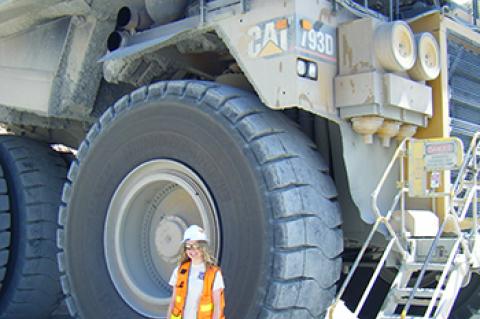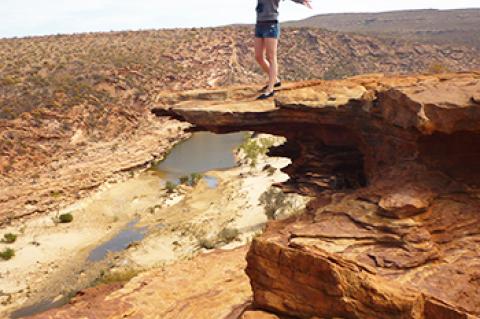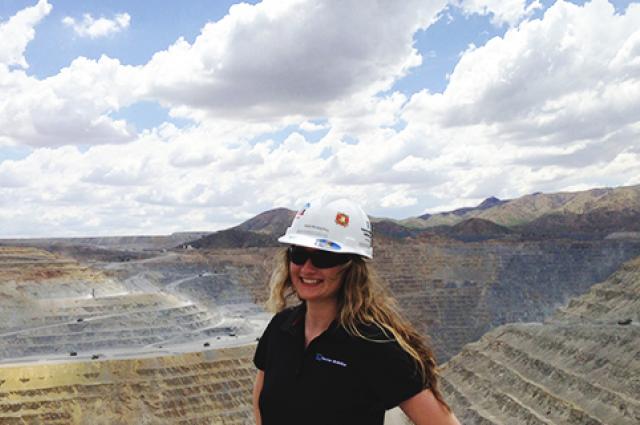Journey to 'Middle of Nowhere' Rounds Out Training
|
Editor’s note: Part of The New Face of Mining celebration -- in which the University of Arizona is commemorating the 125th anniversary of the founding of the Arizona School of Mines -- this is one in a series of articles that follows six mining and geological engineering students through their internship journeys.  Working at a Freeport-McMoRan Inc. mine site for three consecutive summers put the magnitude and complexity of mining into perspective for UA senior Ashlyn Hooten (photo above). Study and travel abroad in Australia gave her a truly global perspective (photo below). See All the UA Mining Engineering Intern Stories: Jamie Mills Builds Mining Life in Oahu Brothers Peter and Paul Mather Carving Niches  Ashlyn Hooten traveling in Western Australia |
UA mining engineering senior Ashlyn Hooten left behind her comfort zone and struck out for the most isolated city on earth to further her training and figure out what comes next. Now the 20-year-old honors student is back at school ready to make the life decisions that lie ahead.
Hooten just finished her third consecutive summer working at the Freeport-McMoRan Inc. Sierrita mine in Arizona, following five months of study abroad in Australia. The internships gave Hooten what the classroom could not: real-life experience. Australia gave her what Arizona could not: a truly global perspective.
Hooten is still debating where to land after her May 2015 graduation, but one thing is certain. Like all UA mining engineering students in a department that boasts a 100 percent job placement rate, she’ll be prepared when the time comes.
Taking a recently offered full-time position at Freeport-McMoRan would launch Hooten’s professional career in a familiar work environment close to her family.
“It would be great to work for Freeport,” she said. “The company does a good job of rotating new engineers through different mine sites and jobs and gives them opportunities to learn and advance.”
Then again, returning to Australia’s fly-in-fly-out mining industry on a one-year work visa could mean the adventure of a lifetime.
“I wouldn’t mind working over there for a year or so if I could,” Hooten said. “It would be exciting.”
Freeport-McMoRan Inc.: The Real Deal
Hooten’s summer jobs at the Sierrita open-pit copper mine about 45 minutes south of Tucson ranged from core sampling minerals the summer after her freshman year, to planning day-to-day mine operations the following summer, to managing the routing of ore grades and waste material after her junior year.
“I have experienced different mining engineering jobs at Freeport and learned far more than I could have learned in the classroom alone,” said Hooten, who earned $25 an hour this summer. “We learn a lot in our mining classes and from books, but in mining you need the hands-on experience to fully understand the processes.”
Even for someone who is no stranger to heavy equipment -- her family runs a construction business in Flagstaff, Arizona -- comprehending the magnitude and complexity of mining operations took being there, and being a part of it.
“We hear how big mining equipment is, and see pictures in books,” she said. “But until you see it, it is hard to fathom haul trucks the size of three-story houses or blasts that break up thousands and thousands of tons of rock.”
While internship programs like those at Freeport-McMoRan help students learn the fundamentals and size up their options, they also help mining companies build a much-needed pipeline of workers.
“We want to develop students so when they graduate they have a vast skill set. They’re knowledgeable, and they have some practical experience within their degree fields,” said Jennifer Durrer, staffing analyst at Freeport-McMoRan Inc., which employs about 230 student interns from throughout North America. “Hopefully they’ll come on board, even if not right after college.”
Australia: Gaining Global Perspective and Catching a Wave
From February through June 2014, before returning to Freeport-McMoRan, Hooten attended the University of Western Australia on the Crawley campus near Perth. The country’s biggest mining town in a region rich in iron ore, Perth is a sprawling city of nearly 2 million that hugs the coastline for 75 miles.
Hooten -- who has received a dozen academic scholarships and will graduate debt free -- took advanced mining classes, lived in college dorms, met students from throughout the world, and was never more than a 30-minute drive from the beach.
“It was good to see what is out there,” she said. “There are so many different places you can go in the mining industry.”
Australia, like the United States, is experiencing a shortage of skilled workers in its burgeoning mining industry, and more and more women are pursuing careers in the field.
However, unlike in the United States, the mining industry there is built largely around a fly-in-fly-out, or FIFO, way of life, and the public has a greater understanding of the importance of mining, Hooten explained.
“Mining is more accepted in Western Australia,” said the UA Engineering Ambassador and former secretary of the student chapter of the Society of Mining, Metallurgy, and Exploration, who has worked to educate K-12 students about mining and help overcome public misperceptions. “It’s more like they developed a lifestyle around the mining industry.”
Many mining sites in Western Australia can be reached only by plane. Upwards of 200,000 workers fly to remote mining operations and typically spend two weeks at a time living in villages on-site and working long shifts seven days a week, before returning home for a week of downtime. Some mining professionals who haven’t yet put down roots spend their time off traveling, a prospect Hooten finds appealing.
Hooten got a taste of the FIFO life when the University of Western Australia flew her class to the Granny Smith Gold Mine, about an hour and 40 minutes from Perth by plane. The mine, like most mines in Western Australia, she said, “was pretty much in the middle of nowhere.”
Hooten also made the most of Western Australia’s other natural resources -- the bush and the beach -- during her weeklong study break, which is similar to spring break in the United States.
She and four other exchange students from Canada and the United States rented a van, with a pop-out tent that hung off the roof to protect campers from critters on the ground, and traveled 800 miles along the coast of Western Australia, staying at national parks, hiking, swimming, snorkeling and surfing -- well, “sort of surfing.”
“It is harder than it looks,” she said.
Hooten’s Australian experience is just what the UA mining and geological engineering department expects and hopes for students who study abroad.
“Mining engineering is an international field,” said Moe Momayez, associate head of the department. “When one of our students has an opportunity to visit another country, we encourage it.”
Ready for the Next Chapter
At the University of Arizona, Hooten has worked at the student-run San Xavier underground mine, was on the Women’s Mine Rescue Team, and competed in the International Intercollegiate Mining Games. She was initially drawn to petroleum engineering and planned to attend the University of Wyoming. But the pull to remain near family won out.
“I’m glad I ended up in mining at the University of Arizona,” she said. “It is a great program, and I feel lucky that I found something I love.”
Whatever happens next, Hooten will be prepared. She has excelled in UA mining engineering, knows the lay of the land at Freeport-McMoRan Inc., and sees great possibilities in the Land of Oz.
In photo at top, University of Arizona mining engineering student Ashlyn Hooten visits a copper mine stateside.


